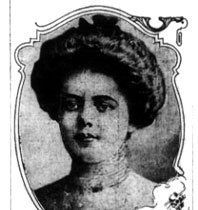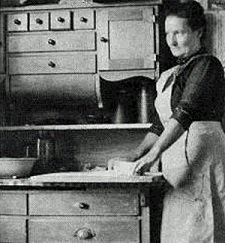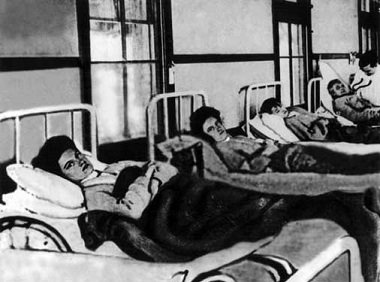Mary ‘Typhoid Mary’ Mallon

Mary Mallon, a woman whose name became synonymous with death and disease, was born in Cookstown, County Tyrone, in 1869. An ironic birthplace, given that it was as a cook that she would become infamous. She emigrated to America in 1884 at the age of 15, and joined her aunt and uncle in New York. There she found work as a domestic servant, rising to the rank of cook through talent and diligence. Her skill saw her employed by some of the richest families in New York, and it seemed that she had found the life most emigrants dreamed of. If things had continued, she might have become famous in quite another way – perhaps through founding a restaurant, or putting her innovative recipes into book form. Unfortunately, it was not meant to be. Because at some point around her thirtieth birthday, Mary got sick.
Typhoid fever is nowadays almost unknown in the western world, though the disease still kills a great number of people in developing countries – 161,000 in 2013. The chlorination of drinking water is the general reason for its reduction where that is practised, though modern antibiotics also help to reduce the fatality rate down from 10-20% to less than 1%. A program of vaccination among the vulnerable areas of the populace prior to the introduction of water treatment is also part of what eradicated it in the Western world, as that also helped to eliminate the secondary means of transmission – the carriers.

Mary survived her brush with typhoid, and in fact may have barely been aware that she had ever contracted it. Not all were so lucky. For the disease had changed Mary – her immune system had reached an uneasy pact with the disease, and now the bacteria swarmed through her system, leaving her untouched (in fact, she was the picture of health) but contaminating everything she touched. [1] The earliest outbreak we can link her to took place in 1900 in the town of Mamaroneck in Westchester County, where within two weeks of her employment there was an outbreak of the disease. Whether she caused the outbreak, or whether this was were she was infected, we cannot know. By the following year she had moved to Manhattan, where she worked in a variety of kitchens over the next five years. And wherever she went typhoid, and death, followed.
In 1906 Mary was employed by Charles Warren, a rich banker, and she accompanied the family that summer to their vacation home at Oyster Bay on Long Island. Summer was when Mary was at her inadvertent deadliest, as one of her speciality dishes was ice cream with peach slices frozen into it. The lack of cooking, and the necessity for handling the slices, made for an ideal transmission medium. In a single week at the end of August, six of the eleven members of the Warren family came down with the disease. The outbreak confounded the local doctors – they knew that typhoid was normally cause by drinking contaminated water, but the rich neighbourhood of Oyster Bay should have had no such problem. Warren decided that he needed to get to the bottom of it, and so he hired a sanitation engineer named George Soper to investigate.

At the time the science of epidemiology was in its infancy, and it was from engineering, among other disciplines, that it was being born. Sanitation engineers such as Soper had been focused on improving public health through improving water quality, environmental hygiene and so on; but the limits of that had just about been reached at this point. Instead they were moving towards targeting the causes of outbreaks, and remedying them directly. It was with this in mind that he examined the factors at play in the Warren household. He soon realised that the water was fine, and food was where he should investigate. At first he suspected the freshwater clams the family had eaten, but then he recognised Mary’s name from another anomalous outbreak. He began researching her employment history, and soon realised that out of the last eight places she had worked, seven had suffered anomalous typhoid outbreaks. Somehow, she was the cause.
Mary, it soon transpired, had never trusted doctors. She particularly didn’t trust doctors who suddenly appeared and insisted that she was sick. (The fact that Soper wasn’t actually a doctor was irrelevant.) Sure, she was the picture of health. When Soper went as far as asking for her blood and “stool samples”, she chased him out of her kitchen with a large meat fork. He was not to be dissuaded, however. He took his research to the New York Department of Health, and was able to link at least one fatality to Mary’s infection. Over the last few years there had been thousands sick with typhoid in New York, and it was clear to the authorities that a dangerous source of infection like Mary needed to be first isolated, and then studied. Accompanied by the police and by Doctor Josephine Baker from the department, Soper returned to Mary’s kitchen. Mary fled to a neighbour’s house and hid in a closet, and it took them five hours to find her and take her into custody. Once there she was compelled to give samples. Despite her outward health, her stool was found to be swarming with the disease and she was immediately quarantined.

The idea that this woman had, unbeknownst to all, been walking among the population spreading a deadly disease immediately became the hottest topic of conversation in the city. The newspapers dubbed her “Typhoid Mary”, and the name would stick. Naturally some pointed to her Irish origins as the source of her contamination, but most were well aware that disease had no respect for race, class or creed. For many the case served to drive home the importance of good hygiene in the kitchen, and the Department of Public Health were swift to capitalise on it in education efforts. However, one person who refused to be educated in the matter was Mary herself. She refused to believe that she could have typhoid, given her robust health. The fact that 120 of the 163 samples doctors took from her tested positive failed to sway her, and when they suggested she have her gallbladder removed (which they suspected was the source of the persistent contamination of her system) she refused. [2] So for two years she was imprisoned on New York’s North Brother Island, in the Riverside Hospital, living in a bungalow on the grounds with, in her words, “only a dog for a companion”. Then, in 1909, she made her bid for freedom.
Mary’s escape attempt came not through swimming the river around the island, but rather through legal channels. She had been sending her own samples off for testing to a private laboratory, and all had came back negative. Knowing what we know, this speaks more to their incompetence than anything else, though it also shows that Mary was not quite the prisoner she liked to portray herself as, if she was able to mail these samples off. Some have speculated that her tests were paid for by William Randolph Hearst, as part of a deal in exchange for an exclusive media deal. If so, then he probably paid for the lawyers who took her case as well. Though the judge ruled in the Health Board’s favour and Mary was not released, the case excited some public sympathy. As a result, the next year they reviewed their guidelines on the treatment of carriers such as Mary. In February 1910 she was released on the condition that she observe strict hygienic guidelines, and that she not work as a cook. They were promises she would not keep.

The health board found a job for Mary as a laundress, but the work was harder and the pay less than she had enjoyed as a cook. Convincing herself that the doctors must have been mistaken, she changed her name and went off their radar, finding work as a cook in kitchens throughout the city buy never staying in a single job long enough for them to find her – or for her to be present when the disease followed in her wake. Her disappearance became known to the public, and it was this that helped the legend of “Typhoid Mary” became firmly established. For five years she roamed around the city, until 1915. Then her luck finally ran out. An outbreak of typhoid at the Sloane Maternity Hospital in Manhattan drew the attention of the Health Board. In the kitchen they found “Mary Brown”, an Irishwoman who the other staff had jokingly referred to as “Typhoid Mary”. They had no idea it was no joke.
Mary was taken back into custody. The two deaths from the outbreak at the hospital destroyed any sympathy the public might have had for her, and helped to ensure that she would stay on North Brother Island for the rest of her life. They did allow her to be interviewed by the media, though they cautioned them to accept nothing from her. By 1922 they began to let her help around the hospital, and eventually she was listed on the books as a “hospital helper”. On Christmas morning, 1932, she was found collapsed on the floor of her bungalow. She had suffered a stroke, and would never regain the ability to walk. For the next six years she was confined to a hospital bed, until she died six years later.

Over the years Mary became enough of a folk legend that people are often surprised to find that there was a real person behind the tale. The quiet terror engendered in the public between 1910 and 1915, while she was about anonymously, were the fertile ground that this myth sprouted from. This public fear may explain why she faced harsher treatment than other “healthy carriers”, some of whom would also break the terms of their release without facing such harsh punishment. On the other hand, it’s possible that today she would be facing murder charges for the two people who died in 1915, not to mention the unknown number who she infected in the time in between. Modern apologists claim that the fault lies with the Health Board, for not explaining to her that she was a carrier. But it’s hard to believe that she would not have become acquainted with their ideas when she filed her suit for release in 1909. She refused to believe, and her stubborn refusal cost at least two people their lives, perhaps more. Balanced against that, twenty three years imprisonment doesn’t seem that unfair.
Images via wikimedia except where stated.
[1] This was by no means a unique condition. It’s estimated that around 3% of typhoid survivors become carriers, though they only became noticeable once the normal transmission of the disease became less common.
[2] It wouldn’t have helped. Scientists recently determined that healthy carriers of typhoid actually have the disease embedded in their macrophages – one of their white blood cell types.
